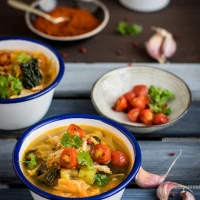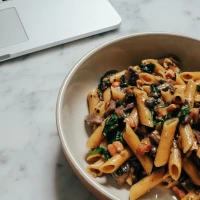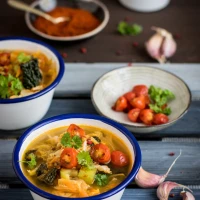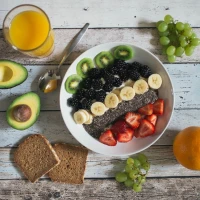Spaghetti, a staple in many diets around the globe, often finds its way to our dining tables in a hearty, twirlable mound of delight. But have you ever paused to wonder about the energy content packed into that inviting bowl of pasta? In our calorie-conscious world, understanding the energy content of our meals is crucial. This narrative aims to dive deep into the caloric composition of a bowl of spaghetti, offering insights on how pasta fuels our bodies and how it fits into various eating plans.
Embarking on a journey through the winding strands of pasta, we’ll unfold a comprehensive exploration of bowl of spaghetti calories. Whether you’re a fitness enthusiast tracking your intake, a health-conscious individual seeking balance, or simply a pasta aficionado curious about your favorite food’s energy content, this guide offers valuable knowledge tailored to satiate your informational appetite.
Understanding the Energy in a Bowl of Spaghetti
Before we dissect the calorie count, let’s establish what constitutes a ‘bowl’ of spaghetti. While serving sizes can differ, a standard portion is frequently measured as about two ounces (56 grams) of dry pasta, which translates into approximately one cup of cooked pasta.
The Bare Basics: Plain Spaghetti Calories
Let’s start by inspecting a bowl of plain, cooked spaghetti — devoid of any frills, sauces, or accompaniments.
- Cooked Spaghetti (Standard Portion): Roughly 220 calories
- Protein Content: 8 grams (providing structure and essential amino acids)
- Carbohydrates: 43 grams (fueling your body with energy)
- Dietary Fiber: 2.5 grams (aiding digestive health)
These nutritional values can of course fluctuate depending on the type of pasta and the exact serving size. Henceforth, we shall navigate through different types of spaghetti and their respective caloric values.
Whole Wheat vs. Refined: A Caloric Confrontation
Choosing between whole wheat and refined spaghetti can affect not only your health but also your daily calorie count.
- Whole Wheat Spaghetti: Often contains slightly fewer calories than its refined counterpart and provides a generous boost in dietary fiber, benefiting long-term health and satiety.
- Refined Spaghetti: May have marginally more calories and less fiber, therefore taking care to balance this with nutritious toppings is essential.
The Calorie Amplification: Sauces and Toppings
Introducing sauces and toppings into your bowl of spaghetti propels the calorie count into a new orbit. Whether it’s a rich meat sauce, a sprinkle of parmesan, or a dollop of creamy Alfredo, each addition carefully crafts the final caloric masterpiece.
A Saucy Matter
- Marinara: A cup of marinara sauce may tack on approximately 80 to 100 extra calories.
- Alfredo: One serving can surge with an additional 100 to 150 calories, predominantly from fat.
- Meat Sauce: Could hoist the caloric content by roughly 130 to 200 calories, depending on the meat’s leanness.
The Toppings Territory
- Cheese: A mere ounce of grated parmesan cheese introduces around 110 calories.
- Vegetables: Nutritious and generally low in calories, veggies like mushrooms, onions, or bell peppers add minimal calories while maximizing health benefits.
- Meats: Options like meatballs or sausage significantly escalate calorie totals, with just two medium-sized meatballs adding about 150 calories to your meal.
As we dissect the various layers that contribute to the energy content of a bowl of spaghetti, it’s clear that customization is key. Balancing the act between delicious indulgence and nutritional management requires mindfulness and knowledge, keystones to both savoring your pasta and honoring your health goals.
The Caloric Impact of Preparation Methods
Not only ingredients but also the method of preparation can influence the bowl of spaghetti calories. Let’s delve into how cooking techniques can sway the energy content on your plate.
Al Dente vs. Overcooked: A Caloric Comparison
While cooking pasta ‘al dente’ — firm to the bite — might not markedly affect calories, it influences the pasta’s glycemic index, potentially impacting blood sugar levels and satiety.
Opting for al dente preparation bolsters the spaghetti’s ability to keep you fuller for longer, marginally aiding in weight management. Conversely, overcooked pasta might digest more quickly, leading to earlier hunger pangs.
Oil in Boiling Water: A Slippy Slope
The common practice of adding oil to boiling pasta water might prevent sticking, but it introduces additional fat and calories without enhancing flavor or nutritional value.
Does Draining and Rinsing Pasta Reduce Calories?
While rinsing cooked pasta under cold water might reduce its starchiness (and thus, lower its glycemic index), it doesn’t have a significant impact on its calorie content.
Analyzing the fundamental principles of pasta preparation has unraveled how each step from pot to plate can subtly influence the nutritional landscape of our beloved spaghetti bowl. It’s not merely about the raw calories but the overall eating experience and energy utilization affected by these details.
Spaghetti in the Context of Diet and Health
The contemplation over a bowl of spaghetti calories naturally progresses to its role within various dietary frameworks. Pasta, often wrongly demonized in low-carb circles, can harmoniously exist within a balanced diet.
The Mediterranean Diet: Embracing Spaghetti
The Mediterranean diet, renowned for its health benefits, cordially welcomes spaghetti with open arms, especially when it’s whole grain and aptly portioned.
Low-Glycemic Approach: Pasta’s Potential
As long as it’s paired with fiber-rich vegetables and lean proteins, and cooked al dente, spaghetti can be part of a low-glycemic diet, moderating blood sugar spikes.
Calorie Counting and Portion Control
Those meticulously tracking calorie intake must remember:
- Accurate Measurements: Weigh or measure pasta before cooking for precise calorie counts.
- Mindful Eating: Pair spaghetti with nutrient-dense, low-calorie toppings like steamed vegetables or lean meats to enhance satiety without calorie overload.
Embracing pasta in diet plans is not about deprivation but intelligent integration. Tailoring your bowl of spaghetti to align with health objectives can be as gratifying as it is nourishing.
Pasta and Weight Management: Can They Coexist?
Taking a closer look at how bowl of spaghetti calories fit into a weight management program hinges on understanding energy balance and the role pasta can play in a rounded diet.
Myth-Busting: The Pasta Weight Gain Fallacy
Contrary to popular belief, pasta does not directly cause weight gain; instead, it’s the overall caloric intake and sedentary lifestyle that tip the scales upwards.
Strategic Spaghetti: An Ally in Moderation
Incorporating moderate servings of spaghetti, ideally with low-calorie, high-fiber sauces and toppings, can support weight maintenance or loss as part of a calorie-controlled eating plan.
Here, we debunk the misconception that pasta is an enemy in the ring of weight management. Rather, a bowl of spaghetti can be a versatile contender, adapting to your dietary cornerstones.
Smartly Spicing Up Your Spaghetti Bowl Without Calorie Overload
As we draw toward the culmination of our bowl of spaghetti calories exploration, let’s ignite our creativity by layering flavors into our pasta dishes without significantly boosting the caloric tally.
Herbs and Spices: The Calorie-Free Flavor Enhancers
- Basil, Oregano, and Thyme: Not only do these staples of Italian cuisine enhance the taste without adding calories, but they also bring a bouquet of health benefits such as antioxidants.
- Garlic and Onions: These aromatics intensify the flavor profile while contributing minimal calories and a host of medicinal attributes.
- Chilies and Paprika: For those who enjoy a little heat, these can dial up the excitement in your dish without dialing up the calories.
Lean Proteins: Building Blocks Without Bulk
- Grilled Chicken Breast: A stellar addition of high-quality protein without the heavy calorie count.
- Seafood: Options like shrimp or clams contribute protein and omega-3 fatty acids, perfect for a guilt-free seafood spaghetti.
- Tofu: A plant-based protein source that seamlessly integrates into your sauce, enriching it with nutrients and texture.
Strategizing every sprinkle and stir ensures that our pasta’s zesty zeal does not culminate in unwanted calorie accumulation. Identifying these culinary allies opens up a world of taste without the weight.
The Conclusion: A Balanced Plate Is Your Power Play
Navigating the world of bowl of spaghetti calories has been an intriguing journey through pasta’s pleasurable and practical aspects. Whether meticulously measuring each morsel or sensibly sussing out satiating sauces and toppings, the essence lies in balance and moderation.
A Harmonious Relationship with Food
Viewing our spaghetti bowl not just as a vessel of calories but as an opportunity for nourishment and enjoyment defines our approach to eating.
Nutritionally Sound, Emotionally Satisfying
A bowl of spaghetti, mindfully curated to deliver both energy and epicurean bliss, is a holistic nod to physical health and mental well-being.
Your Bowl, Your Rules
Ultimately, your bowl of spaghetti is a personal canvas. Painting it with the colors of variety, healthfulness, and joy portends a beautiful, sustainable relationship with food and calories.
As we loop back to the beginning, we leave equipped with the knowledge to conjointly cherish and command the calories within our bowls of spaghetti. This symphony of strands reflects not only the artistry of cuisine but the science of sustenance. Here’s to many more bowls of spaghetti, harmonized with our lifestyles and rich in both flavor and fulfillment.










